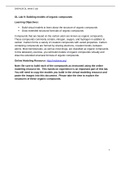-
1. Other - Chem 120 week1 assignment
-
2. Other - Chem120 week 1 assignment
-
3. Other - Chem 120 unit 1 lab ol lab 1 chemistry safety
-
4. Other - Chem 120 unit 1 lab; ol lab 2; atomic structure; assess the possibility of life on ot...
-
5. Other - Chem 120 unit 1 discussion scientific method and atomic structure
-
6. Other - Introduction to general, organic, and biological chemistry with lab
-
7. Other - Chem 120 unit 1 quiz (dec 2020) introduction to general, organic, and biological chem...
-
8. Other - Chem 120 unit 2 lab ol lab 4; ionic and covalent bonds
-
9. Other - Chem 120 unit 2 lab ol lab 3 periodic table of elements
-
10. Other - Chem 120 unit 2 discussion atomic structure (option 2)
-
11. Other - Chem 120 unit 2 quiz (spring 2021) introduction to general, organic, and biological c...
-
12. Other - Chem 120 unit 2 quiz (dec 2020) introduction to general, organic, and biological chem...
-
13. Other - Chem 120 ol, week 3 lab ol lab 5 stoichiometric calculations; identify an unknown com...
-
14. Other - Chem 120 ol, week 3 lab ol lab 6 solution preparation; from salt to solution
-
15. Other - Chem 120 unit 3 discussion solution chemistry introduction to general, organic, and b...
-
16. Other - Chem 120 unit 3 quiz (jan 2021) introduction to general, organic, and biological che...
-
17. Other - Chem 120 unit 4 lab ol lab 7 ideal gas law
-
18. Other - Chem 120 unit 4 lab ol lab 8 acids and bases
-
19. Other - Chem 120 unit 4 discussion chemistry in the world around us
-
20. Exam (elaborations) - Chem 120 unit 4 midterm (jan 2021) introduction to general, organic, and biological c...
-
21. Exam (elaborations) - Chem 120 unit 4 midterm exam (fall 2020) introduction to general, organic, and biolog...
-
22. Exam (elaborations) - Chem 120 unit 4 midterm exam (review) introduction to general, organic, and biologica...
-
23. Other - Chem 120 unit 5 lab ol lab 9 building models of organic compounds
-
24. Other - Chem 120 unit 5 discussion organic chemistry
-
25. Other - Chem 120 unit 5 quiz (feb 2021) introduction to general, organic, and biological chem...
-
26. Other - Chem 120 unit 5 quiz (dec 2020) introduction to general, organic, and biological chem...
-
27. Other - Chem 120 unit 6 lab ol lab 10 nuclear chemistry
-
28. Other - Chem 120 unit 6 lab ol lab 11 carbohydrates the sugars that feed us
-
29. Other - Chem 120 unit 6 discussion option 1: radiation – radioisotope tc-99m
-
30. Other - Chem 120 unit 6 discussion option 2 radiation – topic of uranium-238
-
31. Other - Chem 120 unit 6 quiz (feb 2021) introduction to general, organic, and biological chem...
-
32. Presentation - Chem 120 unit 7 chemistry project: chemistry of nutrition (co 10)
-
33. Other - Chem 120 unit 7 lab ol lab 12 introduction to food macromolecules
-
34. Other - Chem 120 unit 7 lab ol lab 13 protein synthesis
-
35. Other - Chem 120 unit 7 lab practicum introduction to general, organic, and biological chemi...
-
36. Other - Chem 120 week 7 quiz assignment introduction to general, organic, and biological che...
-
37. Other - Chem 120 unit 7 discussion flow of genetic information
-
38. Other - Chem 120 unit 8 discussion lifetimes of plastic
-
39. Exam (elaborations) - Chem 120 week 8 final exam jan 2021 introduction to general, organic, and biological ...
-
Show more




